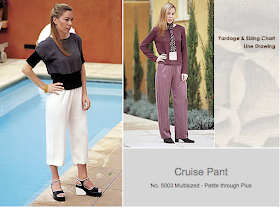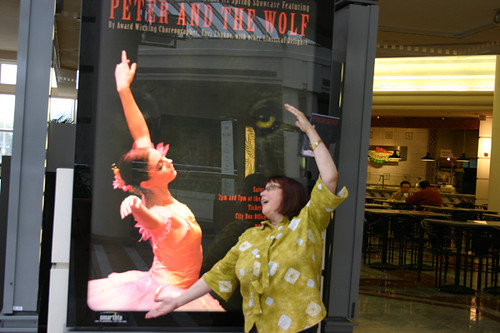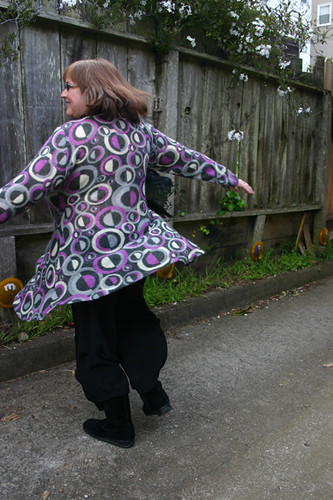
Oops, I am a bit rumpled.

For awhile now I've been wanting to reproduce a pocket detail I've seen in boutique ready to wear - a big round funky pocket. For my first attempt, I started with a pant I'd made twice before, Marcy Tilton's Vogue 8712 made from, you guessed it, black ponte. You can see that version in the pictures below.
It was not quite right. The pocket was too big for the pant leg and the pant leg needed to be looser for the pocket. It's wearable, but I'm glad I didn't use special fabric for the first pair.
I searched for a better pant pattern to start with, but it was tricky. Most of my TNT pant patterns have been fairly fitted through the thigh and I needed something looser. The pant that does fit me loosely through the thigh (which is why I use it so often for PJ bottoms) is the Louise Cutting One Seams, but those pants have no side seam. I asked Louise, via Stitcher's Guild, if I could add a seam on the pant, but she recommended against it, so it was back to the drawing board. (It's nice that she monitors the threads on SG that pertain to her patterns and she is very responsive to any questions or issues.)
A friend then reminded me that the Loes Hinse Oxford pant has a nice relaxed fit and a side seam. I spent probably two hours searching, but I could not find my copy of the pattern. I obviously never put it back after using it several months ago. Rats.
In my search for the Oxfords, I came across the Loes Hinse Cruise pant, which is more tapered at the ankle than the Oxford, but the thigh looked like it had a nice relaxed fit. Deciding to try this pattern, I traced off an XL because I was using a woven fabric for this version and I wanted to make sure I could sit down in these comfortably. :)
The fabric I used is a heavyweight, slightly crinkled, homespun cotton. I bought it in Healdsburg at Fabrications after a retreat last March. (Fabrications is a great store that caters mostly to quilters, but does have some nice non-quilting fabric, like Brussels Washer Linen and silk brocades. It's located in charming downtown Healdsburg which has lots of great shopping and restaurants!)
This fabric is the sort of thing you'd want to use if you were making peasant wear for the Renaissance Faire. ;) I really like it.
When cutting out the pants I realized that, even for the Cruise pattern, the pocket was too big. I finally had a D'OH moment and I tilted the bottom of the pocket pattern several inches outward at the side seam to make it smaller, while retaining the opening size at the top of the pocket. I also placed the pocket lower on the leg so it won't be covered by a longer top.
So, here is version #2, with a smaller pocket. :)
Materials:
- Brown homespun cotton from Fabrications.
- Waistband elastic.
Alterations and Modifications:
Many sewists on Stitcher's Guild cite the Cruise Pant as their favorite Loes Hinse pant. This is saying something since there are many ardent fans of her pants patterns (and her designs in general). Her patterns are designed, by and large, for drapey woven fabrics, especially rayons. They work best in drapey fabrics with some "heft" to them, so silk is not always the best choice, unless it is a 4-ply silk, or a silk burnout, or something along those lines with some weight to it. However, the pattern does say it will work with linen and cotton, so I decided to run with it.
Loes's skill is in drafting her patterns so they really work for women, especially women with maturing figures. For example, the Cruise pant has an elastic waist, and it has darts in the back, but not the front. For those of us with fluffy tummies, this is excellent. When I saw the crotch curve on the Cruise pant, especially on the front crotch, I knew I was in good hands. It has a shallow front curve, similar to Burda and very similar to my TNT crotch curve. I decided to use the curve straight from the pattern. (I usually trace my crotch curve onto a pants pattern from the get-go.)
I made no alterations! I cut out the XL, which is larger than I would ordinarily use, but this version uses a woven and I wanted a relaxed fit. If I make this pant again, in a ponte, for example, I would trace off a large or maybe a medium. By the way, her patterns use 3/8" seam allowances, so take note.
Construction Notes:
- For my first pair of pocket pants, using Vogue 8712, I cut the hole for the pocket about 4" below the raw edge at the waistline. This placed the pocket too high up and it actually "bumped" into the waistband. For this pair, I cut the pocket hole 9.5" below the raw edge at the waistline. I could have placed it a bit higher, but I wanted the pocket to show, even when I'm wearing a long top.
- These pants came together so quickly. In one evening I traced the pattern, cut, and sewed the pants entirely, except for the hems. The pockets were the most involved part of the process and they weren't that bad.
- The pattern allows for a 1.5" hem, and I used a 2.5" hem (approximately) so they were a tad long for me. I usually have to shorten pants patterns, so this is normal.
Conclusion:
I am really happy with my pants! I hope to get lots of wear out of these. And, while I love all my black pants and wear them all the time, it's nice to branch out a bit. :)Pants #1 - Marcy Tilton Vogue 8712




Here you can only see the silhouette of the pant, but I sure like these Marcy pants!
Pants #2 - Loes Hinse Cruise Pant








































